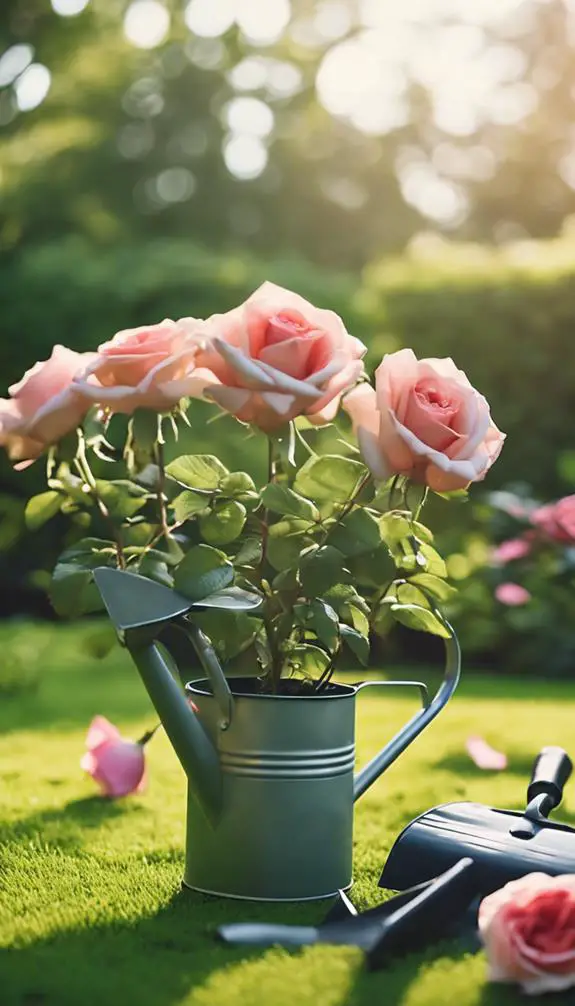As you set out on growing your own salad greens, you'll soon discover the satisfaction of harvesting fresh, crisp leaves right in your own backyard. But before you get started, establishing a strong foundation is crucial. You'll need to choose the right varieties for your climate and taste buds, prepare the soil for ideal growth, and time your sowing just right. Get these basics down, and you'll be rewarded with a bountiful harvest – but what about the finer details that can make all the difference?
Summary
- Select a mix of salad green varieties that suit taste preferences and growing conditions, considering leaf texture and flavor.
- Prepare the soil by adding organic matter, aiming for a well-balanced structure with good drainage, aeration, and water retention.
- Sow seeds 6-8 weeks before the last frost date, at a depth of 2-3 times their diameter, and consider climate-specific sowing techniques.
- Establish a consistent watering routine, providing 1-2 inches of water per week, and maintain a humid microclimate to promote healthy growth.
- Ensure salad greens receive a minimum of 4-6 hours of direct sunlight per day, using light reflection techniques if necessary.
Choosing the Right Salad Greens
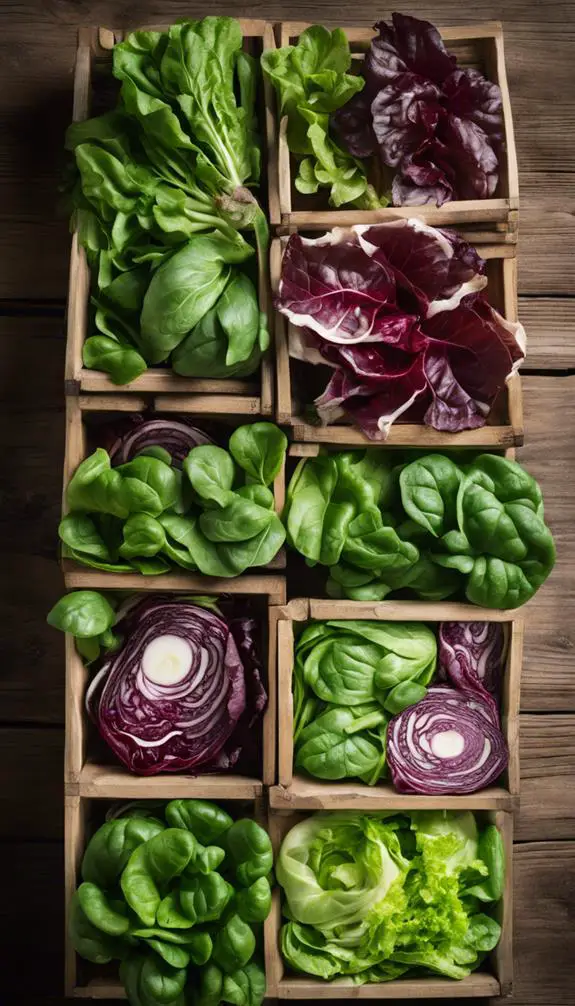
When it comes to growing your own salad, the first step is selecting the right greens.
You'll want to choose a mix of varieties that suit your taste preferences and growing conditions.
Consider the leaf texture you prefer – crunchy, soft, or a mix.
Loose-leaf greens like lettuce, kale, and spinach offer a delicate texture, while crisp heads like romaine and iceberg provide a satisfying crunch.
If you're looking for something unique, try experimenting with bitter greens like arugula or frisée.
Don't be afraid to mix and match varieties to create a blend that suits your taste buds.
With so many options available, you're sure to find the perfect combination to elevate your salad game.
Preparing Your Growing Space
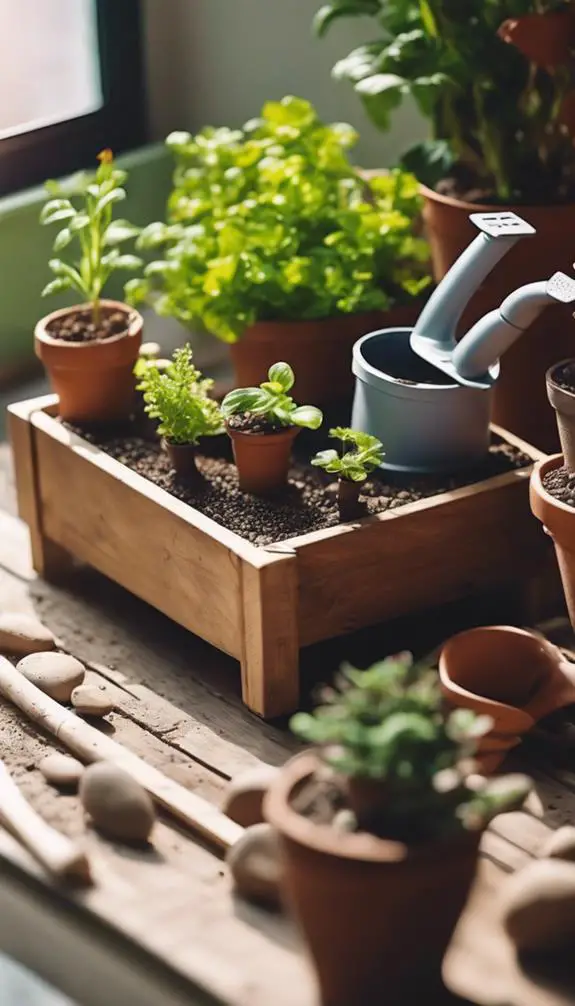
You'll want to start by evaluating your soil quality, as it plays a critical role in the health and flavor of your salad greens.
Since salad greens have varying soil preferences, selecting a mix that's tailored to the specific varieties you're growing is crucial.
Soil Quality Matters
Dig in and get your hands dirty – it's time to prepare your growing space!
When it comes to growing salad greens, soil quality matters. You want a well-balanced soil structure that allows for good drainage, aeration, and water retention.
Aim for a mix with a pH between 6.0 and 7.0, as most salad greens thrive in this range. A healthy soil microbiome is also vital, as it supports plant growth and boosts nutrient uptake.
You can create a favorable soil environment by adding organic matter like compost or manure, which will attract beneficial microorganisms. By focusing on soil quality, you'll set your salad greens up for success and enjoy a bountiful harvest.
Optimal Space Allocation
Your growing space's layout is crucial for ideal salad green production.
To maximize yields, you'll want to optimize space allocation. Consider incorporating vertical gardening techniques to increase growing capacity while minimizing footprint. This approach allows for more plants per square foot, making the most of your available space.
When space planning, prioritize accessibility and airflow. Leave enough room between rows for easy harvesting and pruning. Guarantee adequate spacing between plants to prevent overcrowding, which can lead to disease and pest issues.
Selecting the Ideal Soil Mix

You'll want to select a soil mix that's specifically formulated for salad greens, as the composition matters greatly.
The ideal pH level for most salad greens falls between 6.0 and 7.0, so look for a mix that's optimized for this range.
Additionally, consider a mix with high organic matter content, as this will help retain moisture and nutrients.
Soil Composition Matters
Crafting the ideal soil mix is crucial when growing salad greens, as it directly impacts their flavor, texture, and overall health.
You want a mix that fosters a balanced soil structure, allowing for perfect water retention, drainage, and aeration. This will promote healthy root development and support the growth of dense, crisp leaves.
Additionally, consider the soil biota – the microorganisms that live in the soil. A diverse, thriving soil biota will help break down organic matter, solubilize minerals, and fight off pathogens.
Aim for a mix with a balanced ratio of organic matter, perlite or vermiculite for drainage, and a pH-neutral base like peat moss or coconut coir. This will give your salad greens the best possible start in life.
Optimal Ph Levels
Salad greens thrive in a narrow pH range, and selecting a soil mix that meets these requirements is essential.
pH levels influence nutrient availability, microbial activity, and plant growth.
You'll want to aim for a pH between 6.0 and 7.0, as most salad greens prefer slightly acidic to neutral soils.
Conduct regular pH testing to verify your soil mix remains within this range.
If your soil is too acidic, it can lead to nutrient deficiencies and reduced growth.
On the other hand, acidic soils can be amended with limestone or dolomitic limestone to raise the pH.
Organic Matter Content
Selecting a soil mix rich in organic matter is crucial for growing healthy salad greens, as it directly impacts their ability to access essential nutrients.
You'll want to opt for a mix that contains a minimum of 20% organic matter, which can include compost benefits like improved soil structure and increased water retention. Earthworm castings, in particular, are an excellent addition, as they provide a slow release of nutrients and micronutrients.
When selecting a soil mix, look for ingredients like peat moss, vermiculite, or perlite, which will help to retain moisture and provide aeration for healthy root growth.
Sowing Seeds at the Right Time
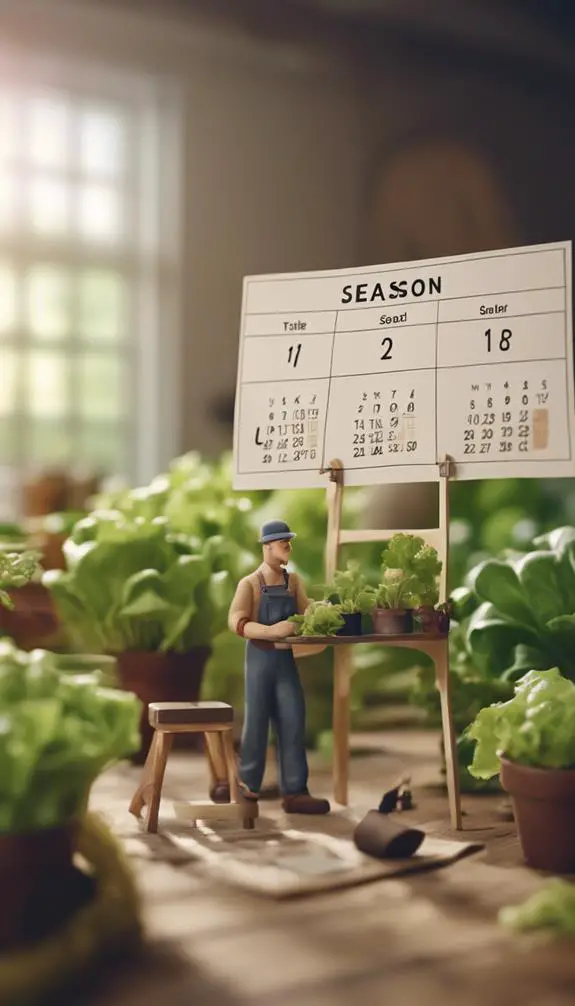
About six to eight weeks before the last frost date in your area, you'll want to start sowing seeds for your salad greens.
This allows the seedlings to mature before the cold weather sets in.
When sowing, consider the climate in your region.
If you live in a hot and dry climate, you'll want to sow seeds deeper to prevent them from drying out.
A general rule of thumb is to sow seeds at a depth of 2-3 times their diameter.
In cooler climates, you can sow seeds closer to the surface.
Climate consideration is key when determining the ideal seed depth.
Watering and Humidity Control
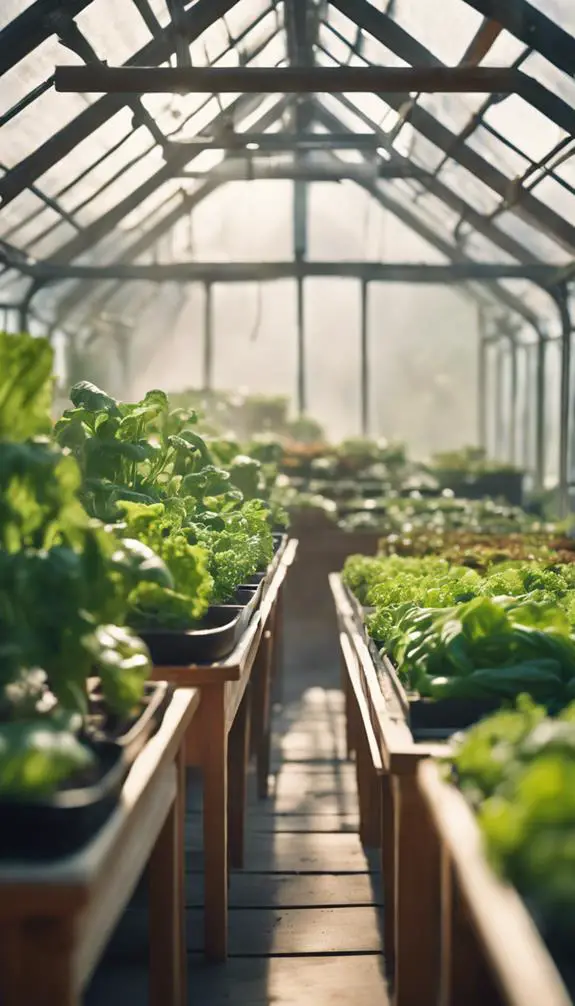
Once you've sown your seeds at the ideal depth, it's time to focus on providing the right amount of moisture to encourage healthy growth.
You'll want to establish a water scheduling routine that guarantees consistent hydration without overwatering. Salad greens require about 1-2 inches of water per week, either from rainfall or irrigation.
Check the soil daily, and water when the top 1-2 inches feel dry to the touch. For peak humidity control, consider using a misting system with a frequency of 2-3 times a day, depending on the ambient temperature and humidity.
This will help maintain a humid microclimate, promoting healthy leaf growth and preventing moisture stress.
Providing Adequate Sunlight
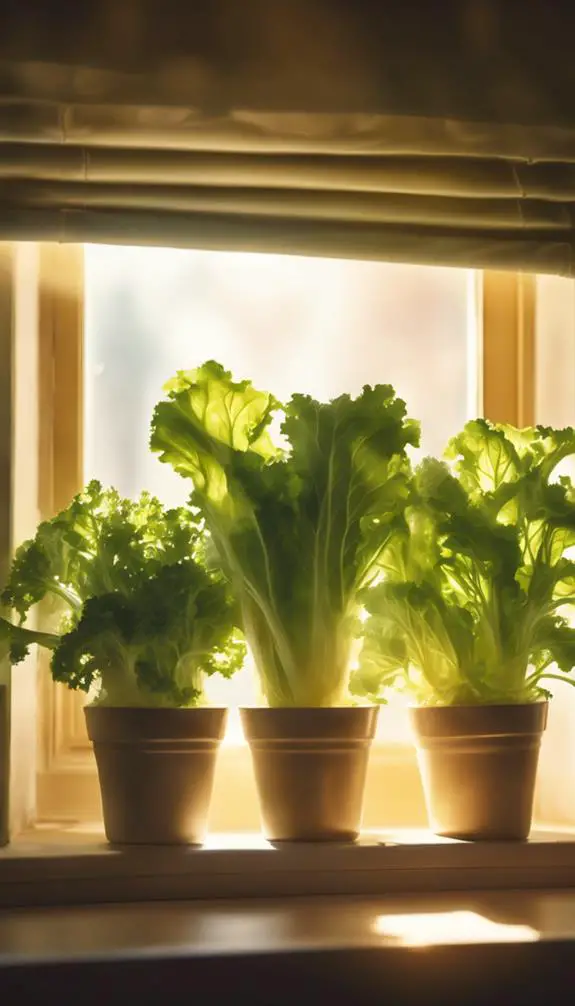
With salad greens requiring a minimum of 4-6 hours of direct sunlight per day, you'll want to position your growing area accordingly.
Guarantee your greens receive the ideal sunlight duration by placing them near a south-facing window or under grow lights. If you're growing outdoors, choose a location that receives direct sunlight for at least half of the day.
To maximize light exposure, consider using light reflection techniques, such as placing a reflective surface, like aluminum foil or a white sheet, around your growing area. This will help increase the amount of sunlight your greens receive, promoting healthy growth and development.
Fertilizing for Optimal Growth

You'll want to guarantee your soil has a balanced nutrient profile to support healthy salad green growth.
Achieving this balance requires understanding what nutrients your plants need and when, as well as how to apply fertilizers effectively.
Soil Nutrient Balance
Salad greens crave a delicate balance of nutrients in the soil to thrive.
You'll want to guarantee your soil provides the necessary nutrients for peak growth. Start by conducting a soil test to determine the pH level and nutrient composition. This will help you identify any deficiencies or excesses.
Understanding nutrient cycling is also vital, as it affects how nutrients are released and absorbed by your salad greens. For instance, nitrogen-fixing bacteria can convert atmospheric nitrogen into a usable form.
Proper Fertilizer Application
Your salad green's fertilization needs are closely tied to the soil's nutrient balance, making careful fertilizer application crucial for ideal growth.
You'll want to choose a custom blend that caters to your greens' specific requirements. Apply a balanced fertilizer at the recommended rate to avoid over-fertilization, which can harm your crops.
For an added boost, consider foliar feeding – a technique that involves spraying a diluted fertilizer solution directly onto the leaves. This method allows your greens to absorb essential nutrients more efficiently.
Be sure to follow the product's instructions and take into account your soil's pH level to maximize nutrient uptake. By fertilizing correctly, you'll be on your way to growing robust, flavorful salad greens.
Controlling Pests and Diseases

As you nurture your delicate greens, pests and diseases can quickly turn a thriving crop into a disappointing loss.
To prevent this, it's vital to implement integrated pest management strategies. Start by maintaining a clean garden environment, removing weeds and debris that can harbor pests.
For flea control, introduce natural predators like ladybugs or lacewings, which feed on flea beetles.
Enhance pest resistance by growing a diverse range of salad greens, including varieties with built-in resistance to common diseases.
Monitor your plants regularly, inspecting for signs of damage or infection.
Use organic or chemical controls as needed, targeting specific pests and diseases to minimize harm to beneficial organisms.
Thinning and Transplanting Seedlings

With your garden environment optimized for healthy growth, it's time to focus on the delicate process of thinning and transplanting seedlings.
You'll want to thin seedlings to about 2-4 inches apart, depending on the variety, to prevent overcrowding and promote air circulation. Use scissors to carefully snip off weaker seedlings at soil level, making sure not to disturb the surrounding soil.
For transplanting, choose healthy seedlings with 2-3 sets of leaves and gently handle them by the leaves, not the stem, to prevent damage. Transplant timing is vital – do it when seedlings have 2-3 sets of leaves and the weather is calm, avoiding direct sunlight and extreme temperatures.
Harvesting at the Right Time
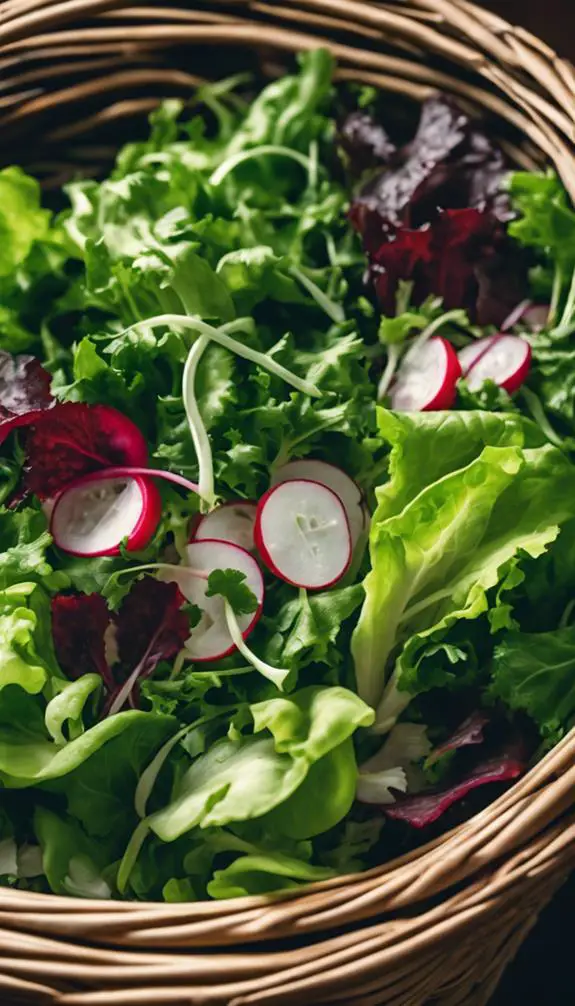
Snip off the largest leaves at the base of the plant to harvest your salad greens, leaving the smaller leaves to continue growing.
This guarantees a continuous supply of fresh greens and encourages the plant to produce more leaves. For a timely harvest, check your plants daily, as some varieties mature quickly.
Harvest in the morning, when leaves are at their crispest, to preserve fresh flavors. Cut leaves just above a node, where a leaf meets the stem, using scissors or pinch them off with your fingers.
Avoid tearing or bruising leaves, as this can lead to spoilage. Regular harvesting promotes bushy growth and prevents plants from flowering, guaranteeing a continuous crop of delicious, fresh salad greens.
Storing Freshly Harvested Greens
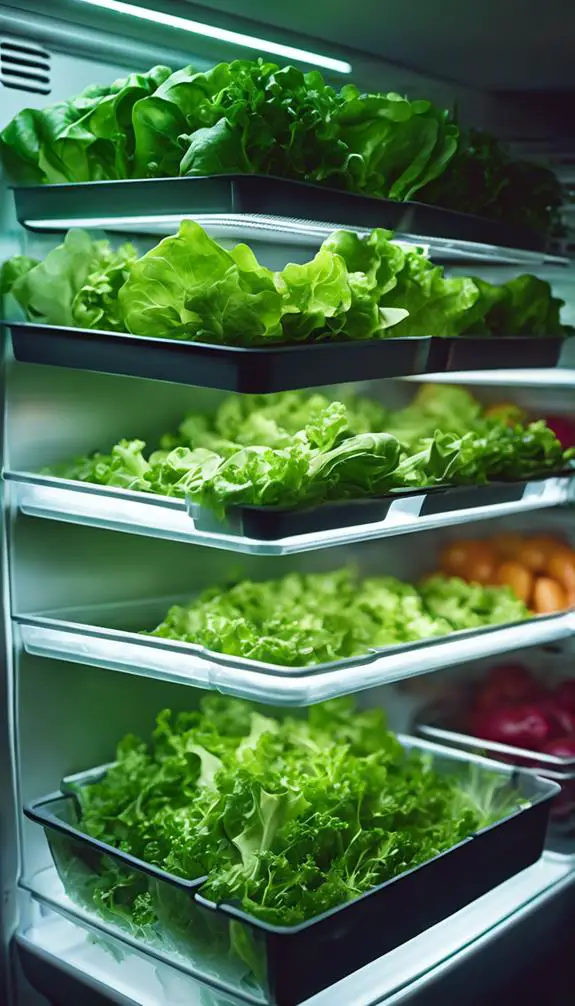
Your freshly harvested salad greens are now ready for storage.
To maintain their freshness, you'll want to store them in a way that prevents moisture and heat from building up.
For fresh storage, gently rinse the leaves with cold water to remove any dirt or debris.
Then, gently shake off excess water and wrap the greens in a breathable material like paper towels or a clean, dry cloth.
You can also use green wrapping, a specialized storage wrap designed specifically for greens, to keep them fresh for longer.
Store the wrapped greens in a sealed container or plastic bag in the refrigerator at a temperature between 32°F and 40°F.
This will keep your salad greens fresh for up to five days.
Troubleshooting Common Issues

When growing salad greens, you'll likely encounter some common issues that can affect the quality and yield of your harvest.
One of the most critical issues is bolting, which occurs when your greens prematurely go to seed. To prevent bolting, guarantee your plants receive consistent moisture and avoid extreme temperature fluctuations.
Light sensitivity is another common issue, as some greens can become bitter or develop off-flavors when exposed to intense light. To mitigate this, provide partial shading or use row covers to filter the light.
Additionally, watch for pests like aphids and slugs, which can quickly decimate your crop. Regularly inspect your plants and take action promptly to address any issues that arise.
Maintaining a Continuous Supply

A continuous supply of fresh salad greens requires careful planning and attention to detail.
To achieve this, you'll need to implement crop rotation and succession planting strategies. Crop rotation involves rotating your salad greens crops every 1-2 weeks to avoid depleting the soil of specific nutrients and to reduce pest and disease buildup.
Succession planting involves planting small batches of seeds every 1-2 weeks to guarantee a steady supply of fresh greens. By doing so, you'll have a continuous harvest and minimize the risk of running out of fresh greens.
This approach will also keep your soil healthy and productive, allowing you to enjoy a bountiful harvest throughout the growing season.
FAQs
Can I Grow Salad Greens Indoors Without Direct Sunlight?
You can successfully grow greens indoors without direct sunlight by leveraging indoor lighting solutions, such as artificial lamps with specific spectrums and intensities, tailored to promote healthy plant development and maximize yields.
Will Wild Animals Eat My Outdoor Salad Green Garden?
You'll need to weigh wildlife deterrents and pest protection for your outdoor garden, as hungry animals like rabbits, deer, and birds might feast on your greens; install fencing, repellents, or covers to safeguard your harvest.
Can I Use a Hydroponic System for Salad Greens?
You can leverage a hydroponic system's benefits, such as increased yields and water efficiency, by customizing it to your specific needs, allowing for precise nutrient control and ideal growing conditions, thereby maximizing your salad green harvest.
How Do I Prevent Salad Greens From Becoming Bitter?
To prevent bitter taste, you'll identify and address factors like temperature, moisture, and light exposure, while tweaking soil quality by adjusting pH, nutrient levels, and microbial balance to optimize your greens' flavor profile.
Can I Grow Salad Greens in a Pot on My Balcony?
You can successfully grow salad greens on your balcony by selecting a pot with good drainage and a minimum depth of 6-8 inches, then optimizing balcony conditions like sunlight, temperature, and humidity to promote healthy growth.
Conclusion
Now that you've mastered the basics of growing salad greens, maintain a continuous supply by regularly sowing new seeds and harvesting mature leaves. Monitor your crop's progress, addressing any issues promptly to prevent damage. By following these guidelines, you'll enjoy a fresh, nutritious harvest year-round. Remember to store your greens properly to preserve their flavor and texture. Happy growing!


